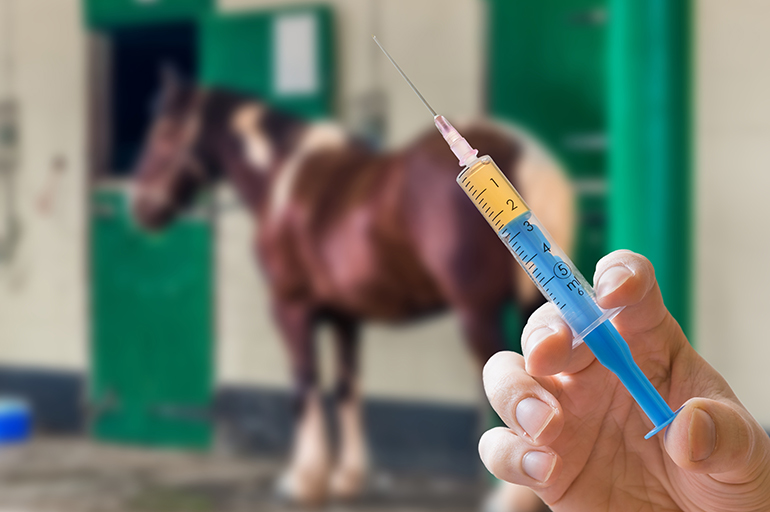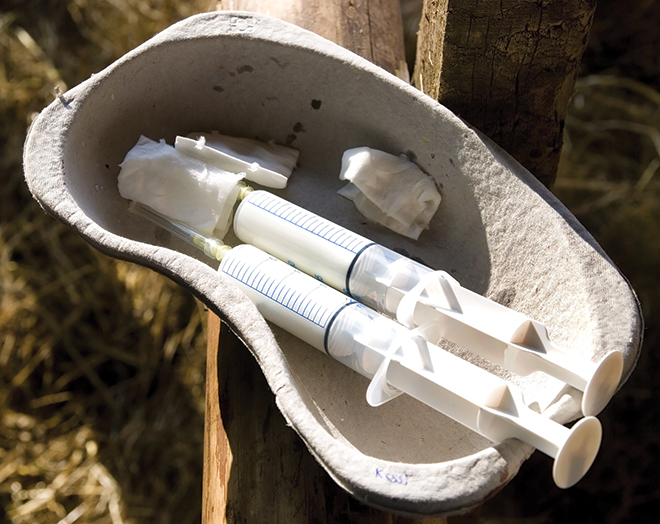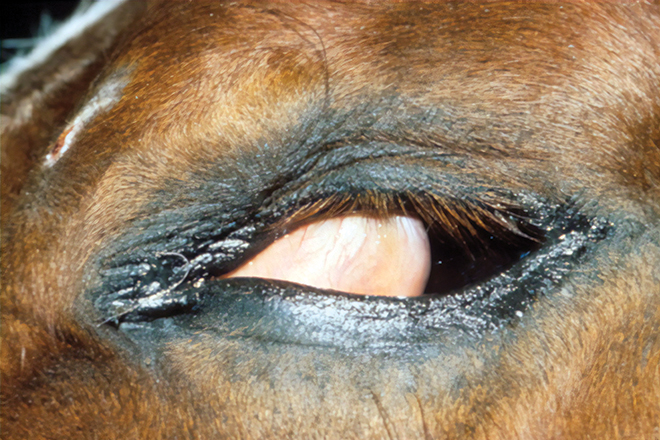
Show horses, as a general rule, are well vaccinated. It’s worth the expense to keep these horses on a regular vaccination schedule for the flu/rhino vaccine (Equine Influenza and Equine Rhinopneumonitis) strangles and equine herpesvirus I and IV since these respiratory viruses may be “shared” between horses.
“Vaccination will help to reduce the chances of your traveling horse becoming sick and reduces the chances your traveling horse brings the diseases home to your other horses,” said Michael Herrin, DVM, the assistant state veterinarian with the Oklahoma Department of Agriculture, Food, and Forestry.
Large events aren’t the only place diseases lurk – they can be present in bacteria in the soil, transmitted by rodents like skunks and by blood sucking insects at home. The American Association of Equine Practitioners (AAEP) in coordination with the American Veterinary Medical Association (AVMA) have identified five core diseases and corresponding vaccine that they recommend for every horse, regardless of age or use, according to Elizabeth Davis, DVM, PhD, DACVIM, a professor and head of the department of clinical sciences at Kansas State University.

The AAEP/AVMA guidelines say five core vaccines “protect from disease that are endemic (occur commonly) to a region, those with potential public health significance (could impact human health), required by law (Rabies must be administered by a veterinarian, by law), virulent / highly infectious and/or those posing a risk of serious disease (meaning the horse is likely to die if they contract disease.”
Those five include, Eastern Equine Encephalomyelitis (EEE) and Western Equine Encephalomyelitis (WEE), Rabies, Tetanus and West Nile Virus. While vaccines are not 100% guaranteed to prevent any disease they significantly reduce the risk of infection. And if a horse becomes sick, the vaccine can reduce the severity of infection. When administered properly, vaccines are safe and effective.
“One carryover misconception from human medicine is the anxiety some people have against vaccines in general, they believe vaccines cause more harm than good,” said Herrin. “In my opinion that is an overreaction to the very rare side effects some people have experienced with some vaccines.”
It’s rare for a horse to have an adverse reaction, but there are exceptions to every rule. Colton McInturff, a resident in equine sports medicine and rehabilitation at Colorado State University in conjunction with Equine Sports Medicine says if this is the case, it needs to be documented in the horse’s medical record and discussed between the veterinarian and the client.
“If the horse has a very bad reaction and has to be hospitalized, then it may not be worth the risk,” he said. “You always have to weigh the benefits of giving a vaccine versus the potential risk a horse may get the disease.”
In the rare chance a veterinarian recommends against a vaccine because of a reaction, that doesn’t mean the horse’s show career is over. The United States Equestrian Federation (USEF) has a protocol for horses that can’t receive certain vaccines that must be followed before and during a competition, but it doesn’t preclude a horse from competing.
“It’s very uncommon, but there are protocols in place to address it and it requires good documentation,” he said.
If you think it’s too expensive to vaccinate a pasture full of non-working horses, think again. In the event a horse contracts one of these five diseases, the medical expenses exceed that of vaccination. And, there’s a strong possibility the horse won’t recover, or recover to its fullest potential.
“When disease can be prevented for less than $100 and when there’s a high cost of treatment with guarded prognosis for survival for horses that are infected, the optimal decision is generally quite evident,” Davis said.
Chances are you’ve heard of the five core vaccines and the diseases they protect against, but you may be less familiar with how the disease is transmitted and the clinical symptoms of infection. In the article that follows, our experts provide specifics on EEE/WWW, Tetanus, Rabies and West Nile Virus.
The disease: EEE/WEE – Eastern Equine
Encephalomyelitis (EEE) and Western
Equine Encephalomyelitis (WEE)
What it is: These viral infections cause serious and potentially fatal brain inflammation, Davis explained. Eastern equine encephalomyelitis most commonly occurs on the east coast of the United States and in some southern states, but the disease has also been identified in Ohio, Michigan and Wisconsin. WEE outbreaks have been reported in the western and Midwestern states.

How it’s transmitted: Mosquitoes. In rare instances, other bloodsucking insects may transfer the virus to horses from wild birds or rodents, which serve as natural hosts for these viruses.
“Viral transmission from a horse to another horse or to a human is extremely unlikely,” Davis said. “The amount of virus in the horses is insufficient to infect a mosquito at a level that would cause disease in another horse or human.”
Clinical signs: The disease is commonly referred to as sleeping sickness because of the degree of depression that occurs in affected horses. This change in demeanor is typically progressive over the course of hours to a day or more. The horse may appear aggressive and, in some cases, loses vision due to the severity of brain swelling, Davis said.
“They hang their head low, go off their feed and do not want to drink,” McInturff added. “They typically get a very high fever and can eventually become neurologic and be unsteady.”
Prognosis: The outlook is poor. Davis estimates that 75-100% of unvaccinated horses with EEE die. The survival rate is only about 50% for horses that develop WEE.
Vaccination protocol: In adult horses that haven’t previously been vaccinated, a two-dose series is given four to six weeks apart and followed up with an annual booster, according to McInturff. The same protocol would be used in foals.
“You want to try to get that booster in, preferably before the mosquitoes are proliferating in the environment, especially for horses living in endemic areas,” he said.
The disease: West Nile Virus
What it is: West Nile Virus is a viral infection that spreads between animals, usually vertebrates, and humans.
How it’s transmitted: West Nile virus is typically transmitted through mosquitoes. Outbreaks are seasonal and a direct reflection of mosquito activity. Once a mosquito is infected, it carries the disease for life and spreads the virus to many types of birds and vertebrate hosts, which include horses, mules, donkeys, other species – even people.

“Horses and people are considered “dead end hosts”, they do not serve as reservoirs for the virus,” Davis explained. “Similar to older people, older horses appear more susceptible to develop disease, particularly if not properly vaccinated.”
Clinical signs: Neurologic signs typically develop within one to three weeks following infection.
“You can see things such as muscle tremors, convulsions and they can become quite weak in their hindquarters,” McInturff said. “They can get a high fever as well.”
Davis adds that a poor appetite and teeth grinding may also be observed.
Prognosis: Diagnosis isn’t necessarily a death sentence. According to Davis, about 30% of horses that develop WNV die. Among those that survive, she said that nearly 90% make a full recovery, but treatment may last several months.
Vaccination protocol: Like EEE/WEE, a two-dose series is given about a month apart and followed up with an annual booster.
In highly endemic areas, McInturff says that a booster every six months may even be necessary. And according to Nathaniel A. White II DVM MS DACVS, director of the Equine Disease Communication Center in areas of where EEE is endemic and mosquitos are present year-round twice a year vaccination may provide the best protection.
The disease: Tetanus
What it is: Tetanus is a bacterial disease caused by Clostridium tetani, which is mainly found in organic debris, including horse manure.
“Due to the ubiquitous nature of this bacteria in the equine environment, it is important to have horses well protected from infection,” Davis said.

How it’s transmitted: Like in people, a puncture, laceration or invasive procedure can provide an opportunity for the C. tetani bacteria to enter the body and cause an infection. When the toxin is released it interferes with normal nerve conduction at the level of the spinal cord, Davis explained.
Clinical signs: The toxin causes a loss of inhibition, so there is an exaggeration of muscle contraction referred to as tetany.
“A stiff gait, firm muscles, retraction of the third eyelid are common clinical signs,” she said. “As the disease progresses swallowing is impaired so the horse cannot swallow food or water and is at risk for aspiration pneumonia. Excitement or activity worsens clinical signs.”
In addition, the retraction of the eyeball itself into the socket and spasms of the third eyelid over the eye can occur.
Prognosis: In some cases, horses can be saved, but in many instances with disease progression the horse may be unable to stand. At this point they are difficult to save, according to Davis.
Vaccination protocol: Like the others, this is a two dose initial series with an annual booster.
“The caveat is if a horse has a laceration and it’s been six months or more since the previous vaccination, then typically we recommend administering the vaccine at that time,” McInturff said.
The disease: Rabies
What it is: Rabies is virus is classified within the family Rhabdoviridae.
How it’s transmitted: Rabies is most commonly transmitted by the saliva of an infected wild carnivorous bat or mammal. Skunks, raccoons, possums and fox are the most common animals that spread the disease, though any mammal can get rabies. Even domesticated cats and dogs can have the disease.

Clinical signs: “One of the most clinical symptoms a person would recognize is drooling or excessive saliva production,” McInturff said. “The horse can become irritable and aggressive and uncharacteristic of their normal temperament.”
Davis added that clinical signs can also range from lameness or altered gait to paralysis, weakness or colic in the early stages of disease.
“Interestingly it is uncommon to find a bite wound,” she said. “Fever may or may not be present at the time of initial clinical signs. “The location of the bite wound in relation to the central nervous system determines the type of signs that develop.”
Prognosis: It is 100% fatal. Following the onset of signs death typically occurs within 5-10 days.
Vaccination protocol: Adult horses receive a vaccine that is followed by an annual booster. According to AAEP guidelines, pregnant mares should be vaccinated four to six weeks prior to foaling. Foals should not be vaccinated prior to six months of age, then be given a two-series vaccination and annual booster.
Reporting a disease
To date, there is no national method for knowing exactly how many cases have been diagnosed. Veterinarians are required to report cases of EEE, Equine Herpes, West Nile Virus and in some states, influenza to their state veterinarian, but not to a national database.
In 2015, the Equine Disease Communication Center (EDCC) was created to compile nationwide data on multiple diseases that include the five deadly diseases, but also extending to Potomac Horse Fever, Vesicular Stomatitis, Anthrax, Equine Infectious Anemia and others. The organization was initially established with funds from the United States Department of Agriculture (USDA), but now relies on funds from the entire horse industry to sustain it.
In 2019, the EDCC received alerts for 146 cases of Eastern Equine Encephalitis, 75 cases of West Nile Virus and one Rabies. When a notification is received, an alert goes out via email and on Facebook. Any person can sign up for the alert service.
“When we get an alert, we try to send it out the same day or even within hours of being received,” White said.
The EDCC relies on state and attending veterinarians for reporting. The state veterinarian first confirms the diagnosis with the treating veterinarian and then those officials submit it to the EDCC.
“We ask owners who are concerned about disease to contact their veterinarian and encourage them to report the disease,” White said. “We hope owners and veterinarians also use the EDCC website resources about diseases and biosecurity during an outbreak to help limit the spread.”



You must be logged in to post a comment Login